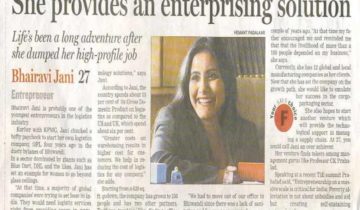‘Start Up India’ is by far the bravest initiative of any government in independent India towards empowering a large number of citizens economically.
On January 16, 2016, Prime Minister Narendra Modi will unveil his plans for the ‘Start Up India’ programme. The programme promises to create a never-seen-before dynamic and enabling ecosystem for entrepreneurship in India. If reports in the media are to be believed, there were one lakh plus requests for invites to the event in New Delhi in an auditorium capacity of 1500. All this excitement reminds me of the melodious AR Rahman composition from the film Roja, ‘Dil hai chota sa, choti si asha… chaand taaron ko chune ki asha, aasmaano mein udane ki asha’ (Have a small heart and have a small wish… I wish to touch the moon and the stars, and I wish to fly in the skies). It is almost two decades since we first heard this composition, but its spirit beckons to Indians in small towns, villages and mega cities even today. Its message speaks to the spirit of a nation long waiting to realize its full potential.
In 2004, when the World Economic Forum (WEF) undertook the scenarios exercise for the future potential of India, they consulted people from different walks of life. The result was four different scenarios; in essence, four different approaches that India could take towards its future development. The scenario that emerged best for India was that of the “Fireflies Rising” – a scenario where individual citizens would have the freedom, opportunity and access to realize their full economic, social and political potential. In their collective success would lie the success of India as an economy and a polity. But the WEF was not the first to recognize this about India. Decades ago, the father of the nation, Mahatma Gandhi coined the word ‘poorna swaraj’ or ‘complete home-rule’ and insisted that political swaraj and independence were the first steps towards the larger goal of ‘poorna swaraj’. Its essence is in every individual having the right to steer his/her life economically, socially, politically, religiously and spiritually.
Political swaraj came 70 years ago, but economic swaraj hasn’t really begun for Indians. The 1991 reforms, for the most part, opened up larger economic constraints, but they did not empower an individual citizen with the means to realize his/her economic potential. The past two decades have seen governments at the centre and the state giving out subsidies and benefits, but not taking the systemic steps necessary to address the issues of unemployment, joblessness and therefore, poverty faced by millions. This has further worsened the situation and taken us away from realising the dream of ‘poorna swaraj’.
Unfortunately, political independence has not given way to economic independence. The Indian polity and its sheer existence is on the premise that a “free India” will enable her citizens to be masters of their own resources, and allow for them a daily life that is bereft of monopolisation, discrimination, entry barriers and resource scarcity. But the lopsided economic policies for decades perpetuated feelings of deprivation, hopelessness, social inferiority and resource scarcity. In such an environment, opportunism has overtaken peaceful co-existence. The tales of jobless youth pelting stones in Kashmir and desperate villagers migrating for survival, to urban youth engaging in crime and villagers affected by Naxalism taking up arms, all lead to one source – the lack of economic self-reliance. Let us not forget that it is only when the fight for the rights of an indigo farmer, or to protect the economic activity of our local weavers or our right to use salt from our own land became the fight of independence, that mass movement towards a “free” India could materialise. Until Gandhiji tied the economic day-to-day challenges of the Indian people to political independence, there was no en-masse participation of Indians towards the freedom struggle.
I believe this struggle is still on, but its manifestation is different. The average Indian, though the direct beneficiary of thousands of schemes and programmes for development, is not an equal participant in the process of national development. The struggle that the ‘aam aadmi’ faces for swaraj is visible in the increasing crime rate, social divide, economic inequity and violence. Therefore, it is time to wake up and do something urgently about changing the factors that perpetuate this vicious cycle of poverty and exclusion.
It is in this context that Prime Minister Narendra Modi’s Independence Day address on August 15, 2015, touched a chord with millions. His clarion call for ‘Start up India and Stand up India’ reached out to the unfulfilled economic aspirations of millions. It reminded us of the march we must continue towards our goal of ‘poorna swaraj’, it rekindled the hope of the scenario of a million fireflies rising and spoke to the small wishes of millions of Indians who want to touch the moon and the stars. ‘Start Up India’ is by far the bravest initiative of any government in independent India towards empowering a large number of citizens economically.
The initiative is not about “free handouts”, it clearly appeals to the enterprising and aspiring Indian. It speaks of creating an ecosystem for start ups in the manner where anyone and everyone can dream and dream big. It removes the first barrier to enterprise and economic self-rule— the barrier of socio-economic class. It is one of the few programmes of any government post-Independence which is open to one and all. You need not be educated, skilled, rich or poor, majority or minority, man or woman to benefit from this program. It is, in essence, a Free Programme of a Free Country to create millions of Free Enterprises through a structured ecosystem that involves the public and private sector in a never-seen-before partnership. But it does not stop there, it does something more.
‘Start Up India’ in true sense strengthens the foundations of economic swaraj. Without this strengthening, the social, racial, religious divides will continue. How many tribals convert to a religious sect even today just to be able to feed their mouths? How many people continue to deepen their racial identity just to be able to avail government benefits? How many people continue to suffer indignity and violence because socially someone else has power over them? From a businessman who pleads in front of a government officer to a rural woman who pleads in front of a schoolteacher, they are all pleading, begging and constantly discounting their dignity so that they may get a permission to run a business or send a child to school. Start Up India, Stand Up India addresses these problems in their roots. The problems of economic disparity, economic inequality and economic suffering. It begins one of the largest ever economic programmes since independence and for the first time instead of experimenting with socialism, capitalism, communism and getting lost in isms, focuses on homegrown solutions for Indians from all walks of life. In that sense, it is truly a nationalist agenda.
Start Up India will focus on building a nation where earning one’s livelihood is a birth-right and generating sustainable livelihoods a responsibility. Whether a person grows, weaves, creates, makes, serves, or uses he partakes in the economic activity out of his/her choice and not compulsion. And that is why it leads to Stand Up India. It is an audacious goal. It is also too simplistic for the economic jingoism one is used to but it has demographics and political environment supporting its case.
The programme begins with a focus on technology and innovation-led enterprises because they are the low-hanging fruits, but if the Prime Minister’s own words are anything to go by then he will not stop here, he wants to march further. That would be not just advisable but necessary. Start Up India cannot stop at a small section of entrepreneurs, but it must manifest into a movement of Economic Independence. It should be about creating and strengthening Aarthik Swaraj (economic self-rule) so that people’s Aajivika (livelihood) and people’s Aamdani (earnings) are a result of their Mahtavakanksha (aspirations) and their Udhyam (enterprise).
The wonderful news is that Indians, despite so many dampeners, have continued to remain aspirational and there are millions of us who aspire to a better life, a better livelihood, a better tomorrow. Start Up India’s final aim should be to create an Udhyam Leher (a wave of enterprise), that can sweep through our very being and allow us to release our unrealised potential as people and nation so that we may continue the journey towards Poorna Swaraj. Anything less would be keeping India away from her true destiny and potential.




